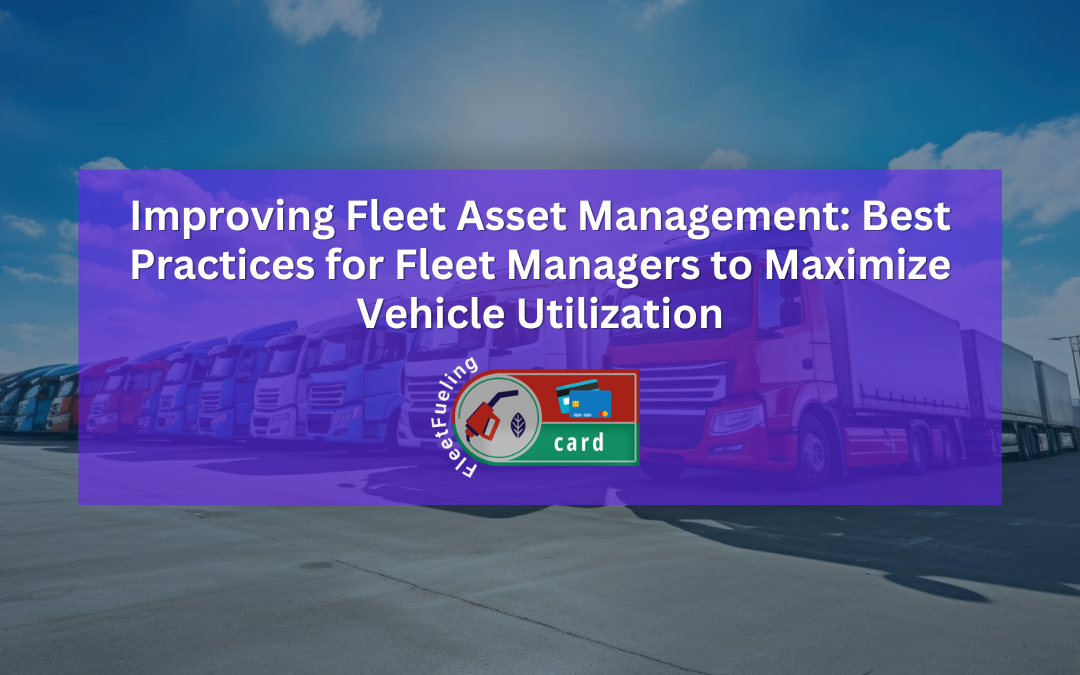Fleet managers are constantly tasked with managing the assets under their care—vehicles, equipment, and other critical resources—ensuring that these assets are used to their fullest potential. Effective fleet asset management is key to maximizing the value of a company’s fleet, reducing costs, and improving overall operational efficiency. However, many fleet managers face challenges when it comes to tracking, maintaining, and optimizing the use of these assets.
In this article, we will explore strategies fleet managers can implement to improve asset management, increase vehicle utilization, and streamline fleet operations. From asset tracking to lifecycle management and improving resource allocation, these practices will help fleet managers get the most out of their fleet assets, ensuring cost-effectiveness and long-term business success.
Why Asset Management is Crucial for Fleet Operations
Asset management is about ensuring that every vehicle and piece of equipment in the fleet is performing optimally and contributing to the company’s goals. For fleet managers, managing assets means balancing operational costs, reducing downtime, and improving overall fleet performance. Without proper asset management, inefficiencies such as underutilized vehicles, excessive maintenance costs, or outdated equipment can significantly reduce the profitability and effectiveness of fleet operations.
Fleet managers must track a variety of factors, including vehicle location, usage rates, maintenance schedules, and asset lifecycles. Proper asset management ensures that resources are allocated efficiently, and that the fleet is always in good working condition and ready to meet business needs.
Additionally, managing assets effectively helps businesses avoid unnecessary investments in new vehicles and equipment. By making sure that current assets are properly utilized and maintained, fleet managers can extend the life of their fleet and avoid the costs associated with premature replacements.
Key Strategies for Effective Fleet Asset Management
-
Utilize Fleet Management Software for Comprehensive Asset Tracking
The backbone of effective asset management is technology. Fleet management software (FMS) provides fleet managers with real-time insights into the location, condition, and utilization of each vehicle and piece of equipment in the fleet. These software solutions integrate GPS tracking, telematics, and other technologies to give managers a full view of their assets and how they are being used.
Fleet management software allows managers to track important asset data, such as:
- Vehicle location: GPS tracking helps fleet managers monitor where vehicles are at all times, improving security and efficiency.
- Asset utilization: Software can track how often each vehicle or piece of equipment is used, helping fleet managers identify underused assets.
- Maintenance schedules: FMS can track maintenance needs, providing alerts when vehicles are due for service and helping managers schedule timely maintenance to avoid costly repairs.
- Fuel consumption: Telematics data allows managers to monitor fuel usage and identify potential inefficiencies in how assets are operated.
By consolidating all this information into one platform, fleet management software makes it easier to make informed decisions, optimize asset utilization, and reduce unnecessary costs.
-
Optimize Vehicle and Equipment Allocation
Fleet managers are responsible for allocating the right vehicle or piece of equipment to the right job, which requires careful planning and foresight. By optimizing how assets are assigned to tasks, fleet managers can maximize asset utilization and minimize idle time.
For example, smaller vehicles such as vans may be best suited for short, local deliveries, while larger trucks may be needed for long-distance hauls or transporting heavy equipment. If a fleet manager assigns the wrong vehicle for a specific task, it can lead to inefficiencies, increased fuel costs, and unnecessary wear on the vehicle.
Fleet managers can use route optimization software to ensure that each vehicle is being assigned to the most suitable job based on factors such as:
- Vehicle capacity: Ensuring that vehicles are not overloaded or underused.
- Fuel efficiency: Assigning fuel-efficient vehicles to long-distance routes or heavy loads to optimize fuel costs.
- Driver expertise: Matching drivers with vehicles they are most familiar with can improve operational efficiency and safety.
Optimizing asset allocation ensures that each vehicle is being utilized to its fullest potential, reducing downtime and unnecessary expenses.
-
Implement a Preventive Maintenance Program to Extend Asset Lifecycles
Preventive maintenance is a key component of fleet asset management, as it helps ensure that vehicles and equipment are kept in good working order throughout their lifecycle. Regular maintenance reduces the likelihood of unexpected breakdowns, increases vehicle reliability, and extends the overall life of the asset.
Fleet managers should implement a structured preventive maintenance program that includes:
- Scheduled inspections: Regular inspections help identify small issues before they become major problems that could lead to expensive repairs and extended downtime.
- Routine servicing: Tasks like oil changes, tire rotations, and brake inspections are essential for keeping vehicles running smoothly and avoiding costly repairs.
- Asset health monitoring: Using fleet management software and telematics, fleet managers can monitor the health of assets in real time and schedule maintenance based on data-driven insights.
By investing in preventive maintenance, fleet managers can reduce unscheduled downtime, improve asset reliability, and ensure that vehicles are always ready for use. This proactive approach reduces the need for costly repairs and allows fleet managers to maximize asset lifecycles.
-
Track and Manage Asset Lifecycle Costs
Every vehicle or piece of equipment in a fleet has a lifecycle, which includes its acquisition, use, maintenance, and eventual disposal. To maximize asset utilization and reduce unnecessary expenses, fleet managers must track the full lifecycle of each asset and make data-driven decisions about when to replace or retire assets.
Key factors to consider when managing asset lifecycles include:
- Acquisition costs: Fleet managers should evaluate whether the cost of purchasing a new vehicle or piece of equipment is justified by its expected return on investment (ROI) in terms of reliability, maintenance costs, and overall efficiency.
- Maintenance costs: Older assets tend to require more frequent and expensive maintenance. Fleet managers should track the cost of maintaining each vehicle over time and compare it to the cost of replacement to determine when it’s time to invest in a new asset.
- Depreciation: Vehicles and equipment lose value over time. Fleet managers should calculate depreciation and consider how it impacts the overall value of the asset and its long-term cost-effectiveness.
- Disposal and resale: When an asset reaches the end of its useful life, fleet managers should consider how to dispose of or sell the vehicle or equipment. Proper asset disposal can help recoup some of the costs and ensure that outdated or inefficient assets are not draining resources.
By tracking and managing asset lifecycles effectively, fleet managers can make informed decisions about asset replacement and maximize the return on investment for each vehicle or piece of equipment in the fleet.
-
Focus on Driver Training and Accountability
Drivers play a significant role in the performance and lifespan of fleet assets. Poor driving habits, such as excessive idling, harsh braking, and overloading, can lead to unnecessary wear on vehicles and reduced efficiency. Fleet managers should invest in driver training programs to promote responsible driving and asset care.
Driver training should focus on:
- Fuel-efficient driving habits: Encouraging drivers to adopt smooth acceleration, maintain steady speeds, and reduce idling can improve fuel efficiency and reduce wear on the vehicle.
- Safety practices: Proper safety protocols not only protect drivers but also ensure that vehicles are not damaged in accidents or mishandling.
- Regular vehicle checks: Teaching drivers to perform basic vehicle checks before each shift, such as tire pressure and fluid levels, can prevent minor issues from turning into costly problems.
In addition to training, fleet managers can use telematics to monitor driver behavior in real time. By tracking factors such as speeding, braking, and idling, fleet managers can provide feedback and incentivize drivers who demonstrate good driving habits, improving asset utilization and extending the life of the fleet.
Maximizing Fleet Asset Value for Long-Term Success
Effective fleet asset management is crucial for improving operational efficiency, reducing costs, and maximizing the value of a company’s fleet. By leveraging fleet management software, optimizing vehicle allocation, implementing preventive maintenance programs, tracking asset lifecycles, and investing in driver training, fleet managers can ensure that their fleet assets are being used efficiently and maintained for long-term performance.
By focusing on asset management, fleet managers can avoid unnecessary costs, reduce downtime, and improve vehicle reliability, ultimately boosting productivity and profitability. Proper asset management not only helps businesses save money but also contributes to sustainability goals by extending the lifespan of vehicles and reducing the need for frequent replacements.
Fleet managers who prioritize asset optimization and invest in the right tools and processes will see a significant return on investment, ensuring the continued success and efficiency of their fleet operations.


Психолог Психолог 617
**mind vault**
mind vault is a premium cognitive support formula created for adults 45+. It’s thoughtfully designed to help maintain clear thinking
**prostadine**
prostadine is a next-generation prostate support formula designed to help maintain, restore, and enhance optimal male prostate performance.
**sugarmute**
sugarmute is a science-guided nutritional supplement created to help maintain balanced blood sugar while supporting steady energy and mental clarity.
**glpro**
glpro is a natural dietary supplement designed to promote balanced blood sugar levels and curb sugar cravings.
**zencortex**
zencortex contains only the natural ingredients that are effective in supporting incredible hearing naturally.
**mitolyn**
mitolyn a nature-inspired supplement crafted to elevate metabolic activity and support sustainable weight management.
**prodentim**
prodentim an advanced probiotic formulation designed to support exceptional oral hygiene while fortifying teeth and gums.
**yusleep**
yusleep is a gentle, nano-enhanced nightly blend designed to help you drift off quickly, stay asleep longer, and wake feeling clear.
**vittaburn**
vittaburn is a liquid dietary supplement formulated to support healthy weight reduction by increasing metabolic rate, reducing hunger, and promoting fat loss.
**synaptigen**
synaptigen is a next-generation brain support supplement that blends natural nootropics, adaptogens
**nitric boost**
nitric boost is a dietary formula crafted to enhance vitality and promote overall well-being.
**glucore**
glucore is a nutritional supplement that is given to patients daily to assist in maintaining healthy blood sugar and metabolic rates.
**wildgut**
wildgutis a precision-crafted nutritional blend designed to nurture your dog’s digestive tract.
**pinealxt**
pinealxt is a revolutionary supplement that promotes proper pineal gland function and energy levels to support healthy body function.
**energeia**
energeia is the first and only recipe that targets the root cause of stubborn belly fat and Deadly visceral fat.
**boostaro**
boostaro is a specially crafted dietary supplement for men who want to elevate their overall health and vitality.
**prostabliss**
prostabliss is a carefully developed dietary formula aimed at nurturing prostate vitality and improving urinary comfort.
**potent stream**
potent stream is engineered to promote prostate well-being by counteracting the residue that can build up from hard-water minerals within the urinary tract.
**breathe**
breathe is a plant-powered tincture crafted to promote lung performance and enhance your breathing quality.
**hepato burn**
hepato burn is a premium nutritional formula designed to enhance liver function, boost metabolism, and support natural fat breakdown.
**hepatoburn**
hepatoburn is a potent, plant-based formula created to promote optimal liver performance and naturally stimulate fat-burning mechanisms.
**cellufend**
cellufend is a natural supplement developed to support balanced blood sugar levels through a blend of botanical extracts and essential nutrients.
**prodentim**
prodentim is a forward-thinking oral wellness blend crafted to nurture and maintain a balanced mouth microbiome.
**flowforce max**
flowforce max delivers a forward-thinking, plant-focused way to support prostate health—while also helping maintain everyday energy, libido, and overall vitality.
**neuro genica**
neuro genica is a dietary supplement formulated to support nerve health and ease discomfort associated with neuropathy.
**revitag**
revitag is a daily skin-support formula created to promote a healthy complexion and visibly diminish the appearance of skin tags.
**sleeplean**
sleeplean is a US-trusted, naturally focused nighttime support formula that helps your body burn fat while you rest.
**memorylift**
memorylift is an innovative dietary formula designed to naturally nurture brain wellness and sharpen cognitive performance.